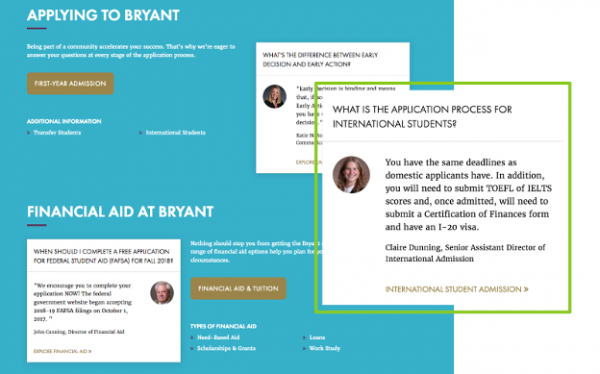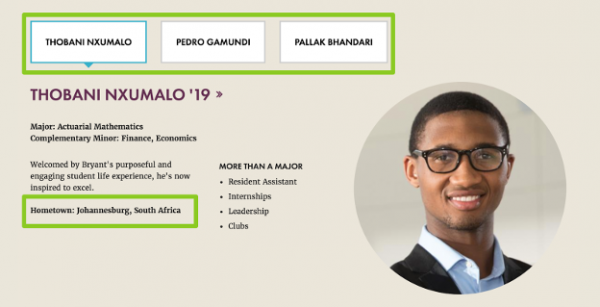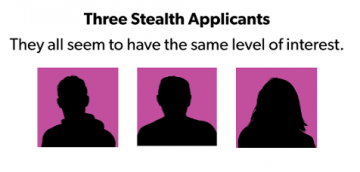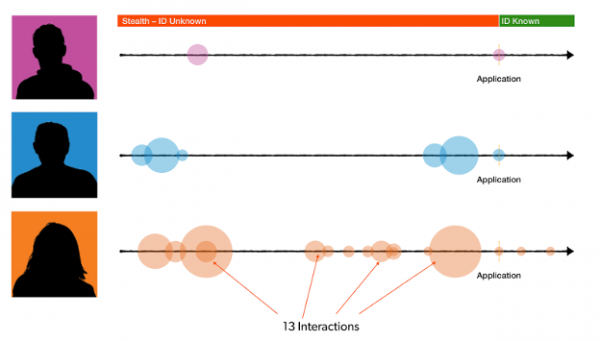
The Only Way to Market to Stealth Applicants
With the undergraduate application being the first entry point for 20% of applicants, enrollment marketing strategies need to change to find and engage these “stealth” applicants.
“What scares me the most? The 80 ‘stealth admits’ that could either make or break our year.”
A university president recently confessed this fear to me highlighting the challenge stealth prospects pose for college and university enrollment teams.
What Is a Stealth Applicant?
Stealth applicants are defined as potential students that have not revealed themselves during the admissions process and don’t show up in the admissions CRM until they submit an application. These prospects are "silent" and thus “hidden” from the admissions team's outreach or any lead nurture programs
Here’s the dilemma: if a majority of this school’s 80 prospects decided to matriculate, the school would be making forced triples — packing three first-year students into a double. On the other hand, if these 80 prospects declined offers of admission, the school would be facing a million dollar budget shortfall.
Admission departments have been wrestling with the rise in stealth applications over the past 10 years. One research report claims that one in five applications is submitted by a stealth applicant.
Since stealth applicants are a reality for enrollment groups, we created two strategies for reaching this troublesome audience.
Why Are There More Stealth Applications?
The prevailing wisdom holds that there are two main causes for the rise in stealth applications: first, the internet is the culprit for the rise in stealth applications — the internet opened up access to information about schools; second, the increased use of the online version of the Common Application permits a prospective student to apply, even without interacting with the school.
The Internet Displaced Admissions as Gatekeeper to Information: The increase in availability of information about the school on the internet decreases the need — or desire — for a prospective student to connect with admissions. As one enrollment marketing observer notes:
“Indeed, the mobile revolution has empowered prospective students to gather ample data about virtually any school to inform their decision about whether to apply for admission.”
The school controlled the content, and the process to access this content. To get this content, a prospect had to call or submit an inquiry card with all of their personal information. Since admissions controlled access to the process, they knew exactly how many prospects were starting the process.
Before the internet, prospective students had to contact a school to get information about the application process, application requirements and, in most cases, the actual paper application.
The Common Application Removed a Reason to Connect with the Admission: The increased adoption of the online version of the Common Application makes it easier for prospective students to apply to a school with a “check of the box.” The online application (that is not hosted or connected to the school’s website) means that a prospective student can make a last minute decision to apply to a school. In addition, there is no need to contact admissions (or visit a school’s website) to receive or start an application.
The internet disrupted the admissions process by removing the school as the gatekeeper and producing multiple entry points into the admission and enrollment funnel that can circumvent the institution.
Thirty years ago it was significantly harder to be a stealth applicant, because there weren't as many ways to become one.
The Enrollment Marketing Challenges
As a result of this disruption of the admissions process, enrollment teams feel the pinch in two ways:
- Without contact information, admissions teams can’t reach out and engage these prospects over the course of the admissions cycle.
- Without an exposed history of contact — or demonstrated interest — an increase in the number of applicants that are stealth can throw off enrollment predictive modeling and reporting.
The disruption increases risk and decreases visibility into the funnel. So, how should schools adapt to the new admissions reality?
Key Strategies for Reaching Stealth Applicants
The internet altered the customer journey of prospective students. To reach these prospective students, we need to adapt our marketing methodologies to align with this new journey.
We’ve developed two ways to counter the challenge of marketing to stealth applicants:
- First, we create motivations to motivate stealth applicants to “reveal” themselves during the admission process.
- Second, while prospects remain anonymous, we use new tools to gather more information during the customer journey.
Using Website Personalization to Market to Stealth Applicants
Website personalization is the only way to send customized marketing messages to a stealth applicant.
Here’s the process:
- Set up a robust personalization engine on your website
- Create a segment for a prospective student based on the data you collect
- Add stealth prospects to this segment and provide them a customized, targeted experience
1. Install the Personalization Engine on Your Website
A personalization engine gives a unique tracking code to each user so that all of their actions on the site are collected from the moment they land on the site. We can also track this information from external sources:
- Source — direct, organic, paid media
- Referral source — e.g., Naviance
- Geographic region — city, state, or zip code
2. Create a segment for prospective students
Once we have the tracking in place, our next step is to understand how “known” prospective students are behaving on the website. We collect this information from the personalization engine.
For one school we worked with, we used analytics to figure out the website behavior of prospective student. We looked at data from every prospect that had completed a request for information form or campus visit form. We identified a set of common behaviors that all of these prospective students exhibited. Some activities included:
- Looked at the major or minor listing and at least one major detail page
- Visited the undergraduate admission pages
- Visited the undergraduate financial aid pages
- Visited the homepage
3. Match stealth users to the prospective student profile
When a stealth user enters the site and maps to the profile of the prospective student — e.g., looking at the majors listing, looked at undergraduate admission page, looked at the undergraduate aid page — we assume this stealth user is a stealth prospect. We add this user to the stealth prospect segment and then we can start marketing to them on the website using the personalization engine.
You might also have sub-segments for stealth applicants — such as international or military or undergraduate, graduate, or prospects from a certain geographic region. The more specific your segmentation criteria, the better your personalization and messaging will be.
Creating a Personalized Marketing Campaign for Stealth Applicants
Now that we have a segment of users, we can use the personalization engine to change the website experience to engage stealth prospects by showing them more relevant content and encourage them to take the next step.
Here’s an example. For Bryant University, we used a personalization engine to engage international prospects. Once we identified the user as an international prospect, we changed the content on the website to be more relevant for these users.
When an international prospect visits the admission and aid page, the generalized/domestic admission information is swapped out for admissions content specific to international prospects: “What is the application process for international students.”

When the site is visited by an international prospect, the gallery is populated with images that resonate more with this audience: images of city life near Bryant (which is more desirable for international students) and the main airport — which is a key question that international prospects ask about.

When the personalization engine is able to identify an international prospect, the site displays only profiles of international students from the library of all student profiles.

Using Website Personalization Data to Understand Expressed Intent
Let’s return to the President who is losing sleep over the 80 stealth admits who can make or break his year. Let’s assume, worst case scenario, that his school had set up personalization on the website and was unsuccessful at converting these stealth applicants.
We can still use the data collected from the personalization engine tracking to reveal the difference in the stealth applicants.
Right now, when a stealth applicant applies, they all seem to express the same level of interest. Admissions knows nothing about their history.

However, these prospects have likely had very different journeys and level of engagement with the school on the website.
With the user tracking that is part of the personalization engine, this history can be collected and analyzed to reveal each prospect’s journey.

Now the President, armed with this type of data, can make some different assessments. If those 80 stealth applicants look like the first stealth example (in purple), he has cause to worry. This stealth prospect looks very un-engaged with only two interactions.
However, if most of the admitted students look like the third prospect (in orange), then he can likely rest easier that these are engaged prospects. And note that the third prospect has also continued to engage with the school website after submitting the application. This is a good sign of interest and “digital expressed intent.”
Summary: Website personalization offers the opportunity to market to stealth applicants and provides specific information for admissions counselors to follow up each of these candidates. The tracking information can improve data modeling for enrollment funnels and improve communication with admitted students.